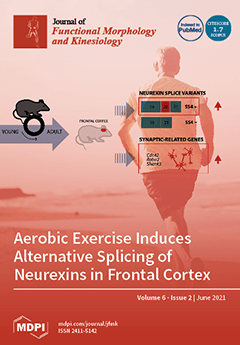Walking tests, such as the 6-min walk test (6MWT), are popular methods of estimating peak oxygen uptake (VO
2peak) in clinical populations. However, the strength of the distance vs. VO
2peak relationship is not strong, and there are no equations for
[...] Read more.
Walking tests, such as the 6-min walk test (6MWT), are popular methods of estimating peak oxygen uptake (VO
2peak) in clinical populations. However, the strength of the distance vs. VO
2peak relationship is not strong, and there are no equations for estimating ventilatory threshold (VT), which is important for training prescription and prognosis. Since the 6MWT is often limited by walking mechanics, prediction equations that include simple additional predictors, such as the terminal rating of perceived exertion (RPE), hold the potential for improving the prediction of VO
2max and VT. Therefore, this study was designed to develop equations for predicting VO
2peak and VT from performance during the 6MWT, on the basis of walking performance and terminal RPE. Clinically stable patients in a cardiac rehabilitation program (
N = 63) performed the 6MWT according to the American Thoracic Society guidelines. At the end of each walk, the subject provided their terminal RPE on a 6–20 Borg scale. Each patient also performed a maximal incremental treadmill test with respiratory gas exchange to measure VO
2peak and VT. There was a good correlation between VO
2peak and 6MWT distance (
r = 0.80) which was improved by adding the terminal RPE in a multiple regression formula (6MWT + RPE, R
2 = 0.71, standard error of estimate, SEE = 1.3 Metabolic Equivalents (METs). The VT was also well correlated with walking performance, 6MWT distance (
r = 0.80), and was improved by the addition of terminal RPE (6MWT + RPE, R
2 = 0.69, SEE = 0.95 METs). The addition of terminal RPE to 6MWT distance improved the prediction of maximal METs and METs at VT, which may have practical applications for exercise prescription.
Full article






